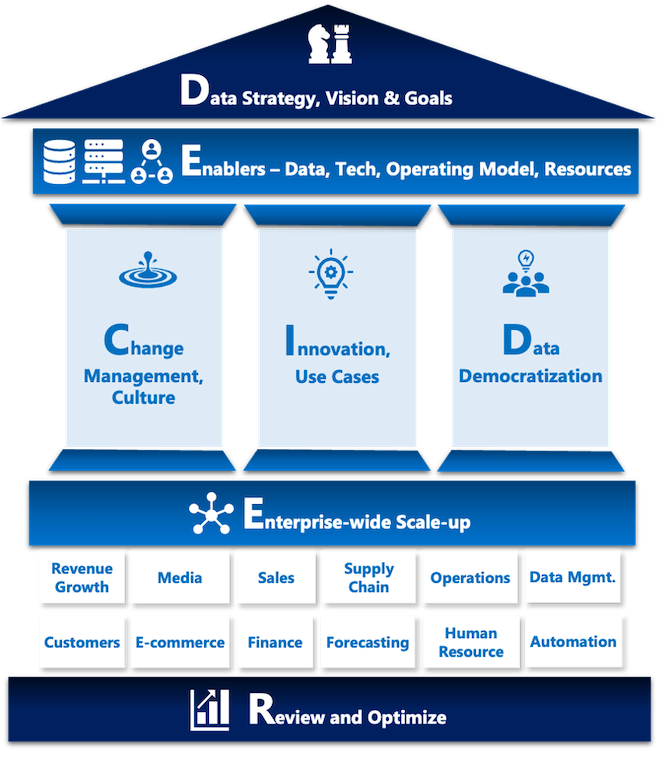
D.E.C.I.D.E.R. Framework
We have created a new framework called D.E.C.I.D.E.R., which provides a comprehensive and structured approach for organizations to become data driven, addressing technical, cultural, and organizational aspects crucial for success.
The framework begins with Data Analytics Vision and Goals (D), emphasizing the need of alignment with the organization's strategic objectives and vision, and the importance of effectively communicating a clear and compelling narrative of desired future state to the entire workforce to encourage collective participation.
The second component Enablers (E), is the core element that supports the data strategy. It includes data enablement and governance practices that treat data as a strategic asset throughout its lifecycle and enable maximum value out of it. Additionally, an optimal operating model facilitates cross-functional collaboration and should be carefully chosen based on the organization’s unique needs. Resources must be adequately secured, including the strategic placement of key roles with a clear understanding of the RACI Matrix (who is responsible, accountable, consulted, or informed) to align ways of working.
The third component is Culture and Change Management (C), Recognizing that successful data initiatives require more than just technical expertise; this component emphasizes cultivating a culture that prioritizes data in decision-making processes. Since cultural inertia can be a significant barrier, this component focuses on assessing readiness for change, measuring impact on teams, and applying behavior change methodologies to facilitate change.
The fourth component, Innovation (I), is key to staying competitive and tapping into opportunities. This component encourages the pursuit of innovative, relevant, high-value analytics, AI, Gen AI, and automation use cases and an application of a new SEED innovation framework to ideate, experiment, and deploy innovative solutions.
The book lists 12 high value use cases with real world success stories that you can apply in your organization. I have shared an evaluation criteria that can help you shortlist, and prioritize use cases, that are feasible as well as high-value.
Data Democratization (D), the fifth component involves equipping business users with the tools and capabilities to access, analyze, and act on data insights independently while ensuring adherence to governance and security standards. This component entails executing a comprehensive plan to develop a Central Decision Management Platform and Self-service solutions, enhancing the decision-making capabilities across the organization..
The next component, Enterprise-wide Scale-Up (E) is about expanding successes across the organization. After securing early wins, the framework calls for a strategic plan for broader transformation across functions. This entails a holistic approach to not only crafting swift solutions but also considering how they will be implemented and scaled.
The final component is Review and Optimize (R). Once you’ve implemented the previous components of the D.E.C.I.D.E.R. framework and your organization actively uses data to make informed decisions, it’s essential to maintain and enhance your data-driven capabilities. The last component of the framework focuses on continuous improvement and refinement of your data strategy and operations.